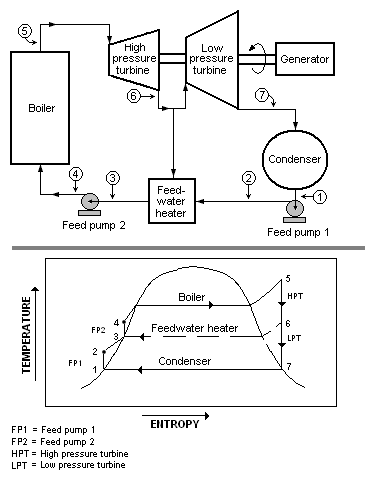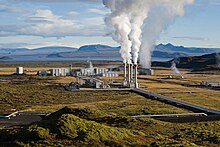Steam-electric power station
This article needs additional citations for verification. (November 2015) |

The steam-electric power station is a power station in which the electric generator is steam driven. Water is heated, turns into steam and spins a steam turbine which drives an electrical generator. After it passes through the turbine, the steam is condensed in a condenser. The greatest variation in the design of steam-electric power plants is due to the different fuel sources.
Almost all
Worldwide, most
History
Reciprocating steam engines have been used for mechanical power sources since the 18th Century, with notable improvements being made by James Watt. The very first commercial central electrical generating stations in New York and London, in 1882, also used reciprocating steam engines. As generator sizes increased, eventually turbines took over due to higher efficiency and lower cost of construction. By the 1920s any central station larger than a few thousand kilowatts would use a turbine prime mover.
Efficiency
The efficiency of a conventional steam-electric power plant, defined as energy produced by the plant divided by the heating value of the fuel consumed by it, is typically 33 to 48%, limited as all heat engines are by the laws of
Since the efficiency of the plant is fundamentally limited by the ratio of the absolute temperatures of the steam at turbine input and output, efficiency improvements require use of higher temperature, and therefore higher pressure, steam. Historically, other working fluids such as mercury have been experimentally used in a mercury vapour turbine power plant, since these can attain higher temperatures than water at lower working pressures. However, poor heat transfer properties and the obvious hazard of toxicity have ruled out mercury as a working fluid.
Another option is using a
Components Of Steam plant
Condenser

Steam-electric power plants use a surface condenser cooled by water circulating through tubes. The steam which was used to turn the turbine is exhausted into the condenser and is condensed as it comes in contact with the tubes full of cool circulating water. The condensed steam, commonly referred to as condensate. is withdrawn from the bottom of the condenser. The adjacent image is a diagram of a typical surface condenser.[5][6][7][8]
For best efficiency, the temperature in the condenser must be kept as low as practical in order to achieve the lowest possible pressure in the condensing steam. Since the condenser temperature can almost always be kept significantly below 100 °C where the vapor pressure of water is much less than atmospheric pressure, the condenser generally works under vacuum. Thus leaks of non-condensable air into the closed loop must be prevented. Plants operating in hot climates may have to reduce output if their source of condenser cooling water becomes warmer; unfortunately this usually coincides with periods of high electrical demand for air conditioning. If a good source of cooling water is not available, cooling towers may be used to reject waste heat to the atmosphere. A large river or lake can also be used as a heat sink for cooling the condensers; temperature rises in naturally occurring waters may have undesirable ecological effects, but may also incidentally improve yields of fish in some circumstances.[citation needed]
Feedwater heater

In the case of a conventional steam-electric power plant using a
Preheating the feedwater reduces the irreversibilities involved in steam generation and therefore improves the
Boiler
Once this water is inside the

Geothermal plants need no boiler since they use naturally occurring steam sources. Heat exchangers may be used where the geothermal steam is very corrosive or contains excessive suspended solids. Nuclear plants also boil water to raise steam, either directly passing the working steam through the reactor or else using an intermediate heat exchanger.
Superheater
After the steam is conditioned by the drying equipment inside the drum, it is piped from the upper drum area into an elaborate set up of tubing in different areas of the boiler, the areas known as superheater and reheater. The steam vapor picks up energy and is superheated above the saturation temperature. The superheated steam is then piped through the main steam lines to the valves of the high-pressure turbine.
See also
- Boiler
- Combined heat and power
- Cooling tower system
- Flue gas stacks
- Fossil fuel power plant
- Geothermal power
- Nuclear power plant
- Power station
- Thermal power station
- Water-tube boiler
References
- ^ "How electricity is generated - U.S. Energy Information Administration (EIA)".
- ^ https://ntrs.nasa.gov/api/citations/19780073904/downloads/19780073904.pdf [bare URL PDF]
- ^ "Supercritical CO2 Gas Turbines | Wisconsin Energy Institute".
- ^ "Supercritical Carbon Dioxide Can Make Electric Turbines Greener". 25 August 2015.
- ^ ISBN 0-9634570-0-4.
- ^ ISBN 0-07-019435-1.)
{{cite book}}: CS1 maint: multiple names: authors list (link - ^ Air Pollution Control Orientation Course from website of the Air Pollution Training Institute
- ^ Energy savings in steam systems Archived 2007-09-27 at the Wayback Machine Figure 3a, Layout of surface condenser (scroll to page 11 of 34 pdf pages)
- ^ Fundamentals of Steam Power by Kenneth Weston, University of Tulsa
